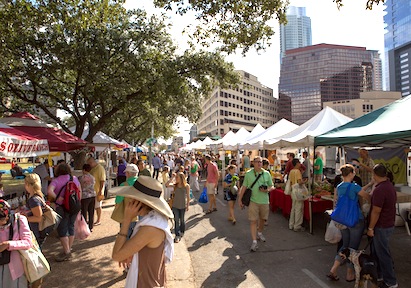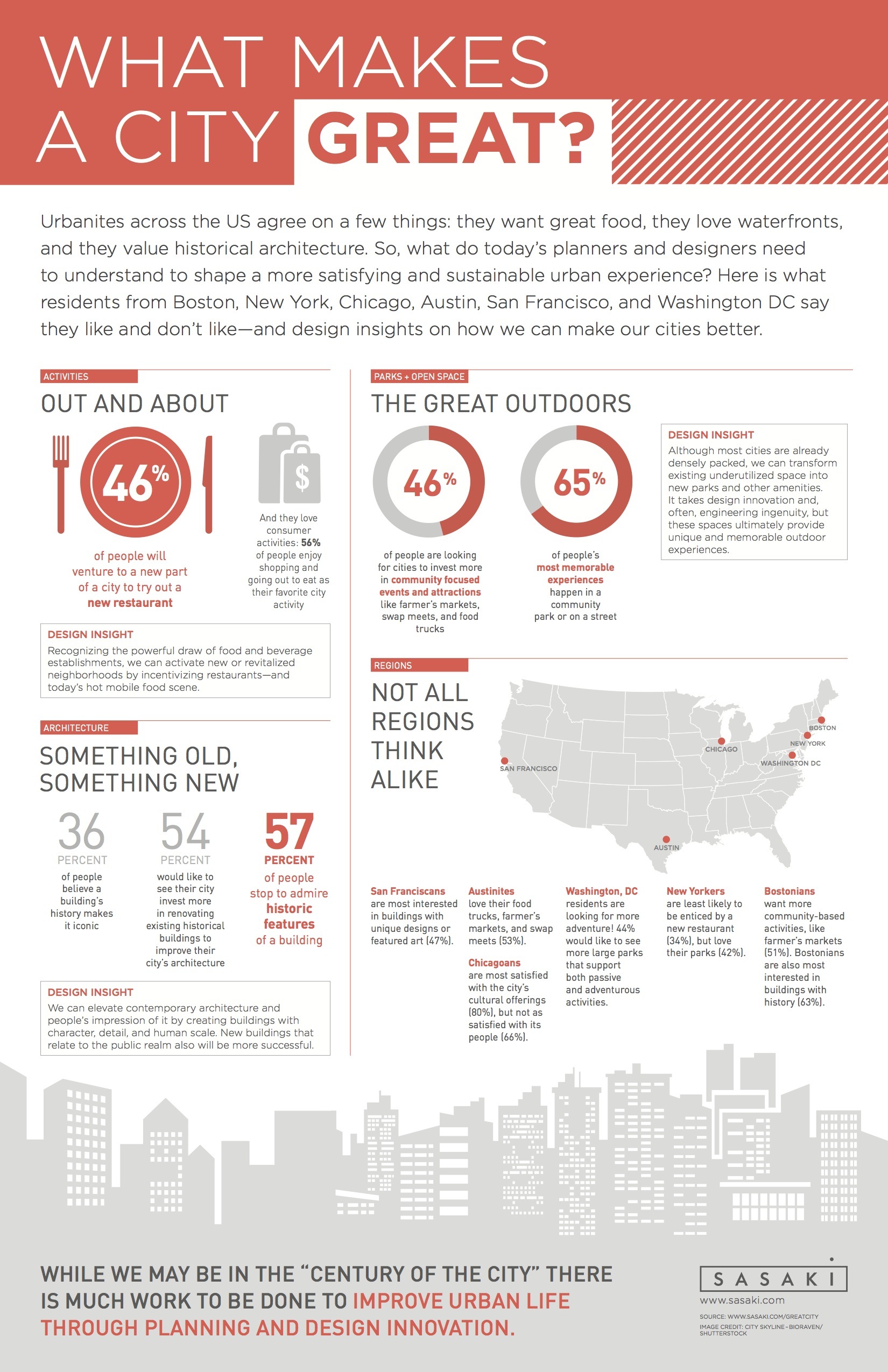A new study released by planning and design firm Sasaki Associates has found that food is a major driver of the American urban experience: 82 percent of urbanites appreciate their city’s culinary offerings, and a new restaurant is the top reason the majority of them (46 percent) would venture to a new part of their city. This is compared to 25 percent of people who are incentivized by a new store and 16 percent by a sporting event.
These preferences vary by region, however, with Bostonians most likely to be enticed by a new restaurant (59 percent) versus New Yorkers (34 percent), whose apparent abundance of choice ranked them lowest on this question. And the majority of people (41 percent) consider food and restaurants to be the most outstanding aspect of cities they love to visit.
Working with an independent research firm, Sasaki developed “The State of the City Experience,” which surveyed 1,000 people living and working in one of six cities: Boston, New York, San Francisco, Chicago, Austin, and Washington DC. The findings—and Sasaki’s insights—related to architecture, activities, parks, and transportation have major implications for cities, planners, and designers.
Beyond food, respondents also enjoy consumer activities such as shopping and going out to eat (56 percent) the most, followed by programmed events such as farmer’s markets, outdoor concerts and food trucks (45 percent). And they want more: 46 percent of respondents said they want their cities to invest in more community-focused events and attractions such as farmer’s markets, swap meets, and food trucks for their open spaces.
As for buildings, people love historic structures. When asked what makes a building iconic, most said it was its history (36 percent). And when walking along a downtown street, most people will stop to admire buildings that are historic (57 percent), versus those featuring public art, modern design, or their city’s tallest buildings.Regionally, Bostonians are the biggest admirers of historic buildings (63 percent), while San Franciscans are more likely to be attracted to buildings that prominently feature public art or very unique design elements (47 percent). Residents of Chicago, which has the nation’s tallest building, are more likely to admire skyscrapers (23 percent).
To improve their city’s architectural character, more than half of respondents (54 percent) would like to see their city renovating historical buildings, compared with22 percent who would like more unusual architecture.
“While those surveyed were unimpressed with modern architecture, we believe it is because today’s contemporary buildings tend to prioritize quantity and speed over quality and mission,” said Sasaki principal Victor Vizgaitis, AIA. “As planners and designers, our job is to understand what people want and balance these desires with the big picture—economic realities, cultural needs, environmental concerns, and design opportunities—ultimately helping to shape a more satisfying and sustainable urban experience.”
When it comes to the built environment, shared public spaces rule the day. Most people remember their favorite city experience taking place in a park or on a street (65 percent) compared to just 22 percent who said that special moment occurred in a private building. This is especially true among New Yorkers.
Reflecting a national trend of cities reclaiming their waterfronts, areas along rivers, lakes, or the ocean are the most popular open spaces across the country (47 percent) compared to 14 percent who prefer small urban parks or 8 percent who like their city’s trail systems.
So, what do Americans hate the most about their cities? Traffic. Overall, 41 percent percent say it’s what frustrates them the most, followed by not enough parking (23 percent) and poor public transportation (14 percent). This provides great opportunity for new technologies to rethink how vehicles can be used more effectively by urbanites, both in terms of commuting and sustainability.
Despite transportation frustrations, 60 percent of city dwellers plan to stay put in the next five years, either living where they do now or in a different part of the city.
The infographic below summarizes key findings. For the full report: www.sasaki.com/greatcity
Methodology
Sasaki commissioned independent research firm Equation Research to survey 1,000 people who live across six cities: Austin, Boston, Chicago, New York, San Francisco, and Washington DC. The study was conducted in May 2014.
About Sasaki
Collaboration is one of today's biggest buzzwords—but at Sasaki, it's at the core of what we do. We see it not just as a working style, but as one of the fundamentals of innovation. Our practice comprises architecture, interior design, planning, urban design, landscape architecture, graphic design, and civil engineering, as well as financial planning and software development. Among these disciplines, we collaborate in equilibrium. From our headquarters in Watertown, Massachusetts, we work locally, nationally, and globally. For more information about Sasaki, please visit: http://www.sasaki.com.
Related Stories
| Aug 11, 2010
SAFTI FIRST hires Tim Nass as National Sales Manager
SAFTI FIRST, a leading USA manufacturer of fire rated glazing and framing systems, is pleased to announce the addition of Tim Nass as National Sales Manager. In his new role, Tim will be working closely with architects and contract glaziers in selecting the appropriate and most economical fire rated glazing solution for their project. He will also be coordinating SAFTI FIRST’s extensive network of architectural representatives throughout the United States.
| Aug 11, 2010
NCARB welcomes new board of directors
The National Council of Architectural Registration Boards (NCARB) introduces its Board of Directors for FY10, who were installed during the culmination of the Council’s 90th Annual Meeting and Conference in Chicago.
| Aug 11, 2010
Berkebile wins $100K award for commitment to environment
Robert Berkebile, the founding principal of BNIM Architects and a founding member of the U.S. Green Building Council, has been selected to receive a $100,000 Heinz Award. The award honors his role in promoting green building design and for his commitment and action toward restoring social, economic, and environmental vitality to America’s communities through sustainable architecture and planning.
| Aug 11, 2010
Polshek Partnership unveils design for University of North Texas business building
New York-based architect Polshek Partnership today unveiled its design scheme for the $70 million Business Leadership Building at the University of North Texas in Denton. Designed to provide UNT’s 5,400-plus business majors the highest level of academic instruction and professional training, the 180,000-sf facility will include an open atrium, an internet café, and numerous study and tutoring rooms—all designed to help develop a spirit of collaboration and team-oriented focus.
| Aug 11, 2010
University of Florida aiming for nation’s first LEED Platinum parking garage
If all goes as planned, the University of Florida’s new $20 million Southwest Parking Garage Complex in Gainesville will soon become the first parking facility in the country to earn LEED Platinum status. Designed by the Boca Raton office of PGAL to meet criteria for the highest LEED certification category, the garage complex includes a six-level, 313,000-sf parking garage (927 spaces) and an attached, 10,000-sf, two-story transportation and parking services office building.
| Aug 11, 2010
Draft NIST report on Cowboys practice facility collapse released for public comment
A fabric-covered, steel frame practice facility owned by the National Football League’s Dallas Cowboys collapsed under wind loads significantly less than those required under applicable design standards, according to a report released today for public comment by the Commerce Department's National Institute of Standards and Technology (NIST).
| Aug 11, 2010
Callison, MulvannyG2 among nation's largest retail design firms, according to BD+C's Giants 300 report
A ranking of the Top 75 Retail Design Firms based on Building Design+Construction's 2009 Giants 300 survey. For more Giants 300 rankings, visit http://www.BDCnetwork.com/Giants








